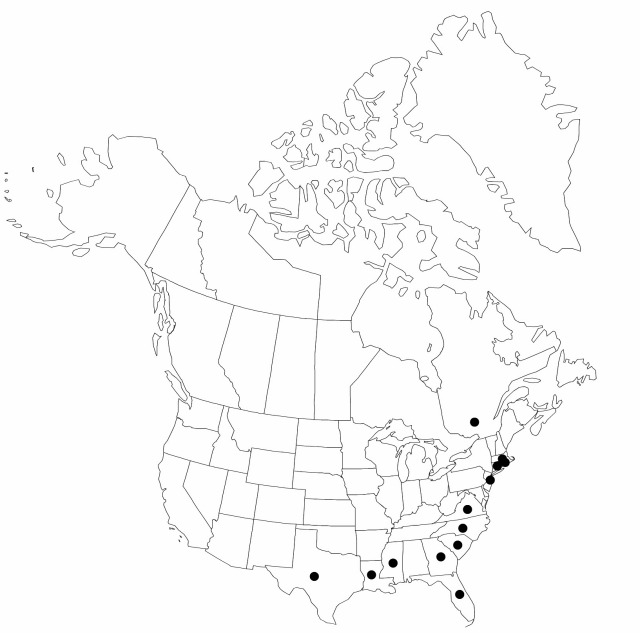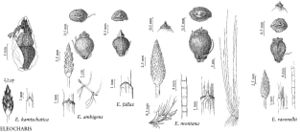Eleocharis ambigens
Rhodora 37: 394. 1935.
Plants perennial, mat-forming; rhizomes evident, long, 1–2 mm thick, firm, cortex persistent, longer internodes 1–3 cm, scales persistent, 5–10 mm, membranous, not fibrous. Culms terete, often with to 16 blunt ridges when dry, 25–80 cm × 0.5–1.5 mm, firm, internally spongy. Leaves: distal leaf sheaths persistent, not splitting, proximally dark red, distally red to stramineous or green, often callose, thinly papery (to membranous), apex dark red-brown, obtuse to subtruncate, tooth sometimes present on some culms, to 0.3 mm. Spikelets ovoid to lanceoloid, 5–23 × 2–3(–4) mm, apex acute (to obtuse); proximal scale amplexicaulous, entire; subproximal scale with flower; floral scales often spreading in fruit, 10–60, 3–4 per mm of rachilla, medium brown, rarely red-brown, midrib regions mostly stramineous to green, in proximal part of spikelet ovate, in distal part lanceolate, 2.5–3.5 × 1.7 mm, entire, apex acute to rarely obtuse, often carinate in distal part of spikelet. Flowers: perianth bristles 2–4(–5), brown, slender to stout, usually very unequal, rudimentary to equaling achene; stamens 3; anthers brown, 1.5–2 mm; styles 2-fid, sometimes some 3-fid. Achenes not persistent, dark yellow or stramineous, obovoid to obpyriform, all biconvex or some (very rarely all) compressedtrigonous, angles obscure, 1–1.5 × 0.9–1.25 mm, apex rounded, neck absent (to very short), finely rugulose at 10–20X, with 20 or more horizontal ridges in vertical series and/or finely cancellate at 10–30X. Tubercles brown or proximally whitish, pyramidal, depressed, rarely some as high as wide, 0.15–0.3(–0.5) × (0.3–)0.4–0.6 mm. 2n = 44, 45, 46.
Phenology: Fruiting spring–summer.
Habitat: Coastal (rarely inland) fresh to brackish pond shores, marshes, disturbed places
Elevation: 0–10 m
Distribution

Que., Conn., Fla., Ga., La., Mass., Miss., N.J., N.C., R.I., S.C., Tex., Va.
Discussion
Eleocharis ambigens is usually treated as a synonym of E. fallax because some specimens from Massachusetts to Georgia have some 3-fid styles and some obscurely trigonous achenes. A specimen of E. ambigens from Louisiana has trigonous achenes. Eleocharis ambigens is very similar to and perhaps better included in E. uniglumis (S.-O. Strandhede 1967). Intermediates with E. macrostachya occur in Louisiana and Texas. The depressed tubercles are diagnostic of E. ambigens. Eleocharis ambigens is sometimes confused with E. montevidensis, which is readily distinguished by its floral scales with broadly rounded apices.
Selected References
None.
